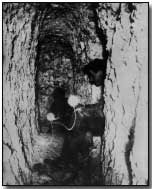Encyclopedia - Listening Post
 Also commonly referred to
as a 'sap-head', a listening post was a shallow, narrow, often disguised
position somewhat in advance of the front
trench line - that is, in
No Man's
Land.
Also commonly referred to
as a 'sap-head', a listening post was a shallow, narrow, often disguised
position somewhat in advance of the front
trench line - that is, in
No Man's
Land.
Listening posts were, as the name suggests, used to monitor enemy activity and to gather intelligence information. As such listening posts could sometimes be sited dangerously close to the enemy front line although they were typically some 30 yards ahead of the front line.
Occupants of listening posts were expected to keep a close watch for any signs of enemy activity in the vicinity, such as mining, preparations for a gas attack (indicated by the presence of gas cylinders), or even for enemy wiring parties.
Following underground mining attacks (such as at Messines in June 1917) strenuous efforts would be made by both sides to gain possession of resultant mine craters, which would often be placed to effective use as new listening posts.
Manning listening posts was considered a dangerous activity given that both sides would often launch raids intended to knock-out enemy sap-heads.
Photograph courtesy of Photos of the Great War website
A Town Major was a staff officer responsible for billeting arrangements in a town or village behind the lines.
- Did you know?
